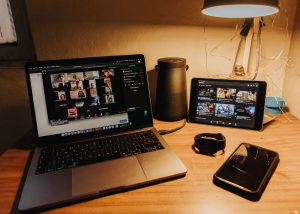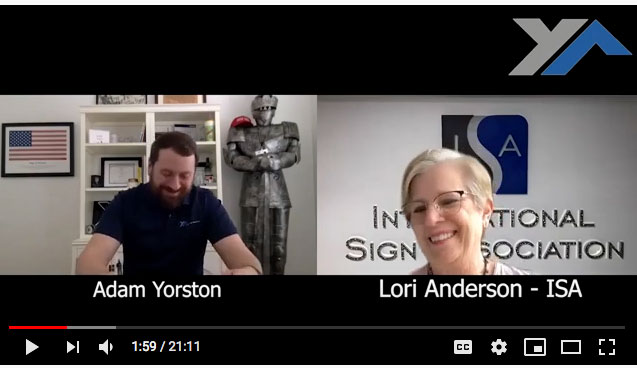 We recently reached out to Adam Yorston, president of Yorston & Associates and member of the ISA Board of Directors about how COVID-19 is affecting his business and his outlook for how it will continue to affect the sign industry. Yorston & Associates has existed for over 35 years as an Independent Rep Agency in the sign industry.
We recently reached out to Adam Yorston, president of Yorston & Associates and member of the ISA Board of Directors about how COVID-19 is affecting his business and his outlook for how it will continue to affect the sign industry. Yorston & Associates has existed for over 35 years as an Independent Rep Agency in the sign industry.
In our Q&A below, Yorston talks the value of technology, the industry’s current outlook and pain points, and what he thinks the industry will look like on the other side of this pandemic.
SBI: How has the COVID-19 pandemic affected the way Y&A does business?
Adam Yorston (AY): Yorston and Associates’ business model focused around traveling around the country to sign companies and distributors introducing products, solutions, and manufacturers to the industry. Travel restrictions placed countrywide have caused us to continue to innovate in the ways we address our day-to-day. We represent some great manufacturers, and before and after COVID-19 our responsibilities still are to sell, promote, and provide solutions to the industry. We knew the digital age of webinars, micro-learning sessions, and videos were growing in popularity. So a few years back we began to focus attention in this direction. COVID accelerated this. Luckily, we have some incredibly innovative people on our team. The current moment is about content, value, and reaction time.
SBI: What are some things Y&A is doing to keep the sign industry informed during this time?
AY: I remember when I found out most regions and manufacturers were going on travel bans—it was March 13th, and I was finishing up a visit knowing I was going into a week of working from home myself. Our team is not to used to this. So we immediately pulled together the whole team via Zoom [a videoconferencing platform] on that following Monday so the team could get comfortable with video chatting. We knew we would be on video for the next couple of weeks at least. We began the process by thinking we need to keep educating and keep our partners in front of our customers.
 We began scheduling virtual trainings with individual sign companies and distributors. By the end of the week, we were being flooded with requests to do these on a larger scale, and to consider other platforms. We quickly put together a schedule, every person on the team brought something different to the table. We began creating interviews with industry influencers, multiple training sessions, live streams, a morning show, and even a well-attended Friday Happy Hour for the industry. This just kept snowballing.
We began scheduling virtual trainings with individual sign companies and distributors. By the end of the week, we were being flooded with requests to do these on a larger scale, and to consider other platforms. We quickly put together a schedule, every person on the team brought something different to the table. We began creating interviews with industry influencers, multiple training sessions, live streams, a morning show, and even a well-attended Friday Happy Hour for the industry. This just kept snowballing.
SBI: Tell us more about the virtual trainings.
AY: Virtual training is a vital part of the new world. At Yorston & Associates, we take the approach of knowing our audience and understand that we’re all busy with work and life. Our trainings are focused to be efficient and bite-sized. Many companies focus on this idea of hour-long seminars. We believe in anything from a three-minute video to a max of a 25-minute education session and discussion. We like to keep our education to 5-15 mins and let the remainder of any training or meeting operate as an open Q&A.
Another big belief of ours is diversity in delivery. Content today needs to be distributed on many different platforms. Whether it is a Facebook Live Stream, YouTube, LinkedIn, Zoom, or a pre-recorded video. Connecting with the audience is important. Often analytics in selling and marketing can be challenging to derive, so we prefer to create situations where interaction can flourish. This helps us listen to what the market wants and needs. We love questions and feedback—it helps us create the next concept.

SBI: Technology has become a big part of the way your company—and many others—are communicating and sharing information now. How do you think technology will play a role in the sign industry moving forward?
AY: What we do today will not disappear. The companies who are embracing the concept of content and distribution of it on multiple platforms will come out of this in a very strong place. The industry moving forward will become much more virtually visual and efficient after this time. I believe companies will begin to pay closer attention to when a video chat could be used versus an in-person meeting. I’m a believer you will never replace the value and connection that take place during an in-person meeting, however, we can all admit not every in-person meeting is crucial. In some cases, we have taken for granted how efficient simple tools like FaceTime, video chats, quick videos, and going live for 15 minutes about one topic to dozens of people can be.
SBI: You deal with a lot of manufacturers, suppliers, and sign shops. What are you hearing? What is the general outlook? What are some of the biggest pain points sign shops are currently experiencing?
AY: We have the honor of traveling and interacting with people across this whole industry. There is a lot of confusion out there about programs available to businesses during these times. There are operational hour changes, personnel changes, but the industry is working hard to get through it. Many people are tuning into some of the education webinars the ISA is hosting right now. These are very helpful. Depending on where you are in the country, the outlook in the moment varies, but it is my opinion shops appear to be optimistic. Corporate branding and messaging is very important in the visual communications industry right now and many sign shops, manufacturers, and distributors are being very innovative in findings ways they fit in these current market conditions.
I think the pain points seem to be navigating through creating future sales going forward until we’re on the other side of this as well as trying to forge new relationships at a time when traveling, cold calling, and in-person meetings are not happening. These relationships can be between new distributors, new products, new wholesalers, and even new end users. Breaking through this challenge will help make the visual communications industry not only stronger but perhaps reinvent its image as a solutions provider during times like these as we move forward.
SBI: What do you predict the sign industry will look like on the other side of the COVID-19 pandemic?
AY: When we enter the post COVID-19 world, people will be more focused not so much on the hours it takes to accomplish a task or how many miles traveled to do something but efficiency and effectiveness of delivering the solution. Our industry will lean into the age of evaluating results.
I do not believe this will reduce value of time, outside sales people, or in-person meetings, but further increase productivity in our great industry. Solutions will be delivered faster. More will be done, with thought behind it, not just because this is how we’ve always done it. There will be a hybrid of personal interaction, virtual interaction, and distribution of content. The ability to train and learn will increase in our industry. Information and messaging will be stronger than ever. After all we are the visual communications industry, aka the sign industry.










